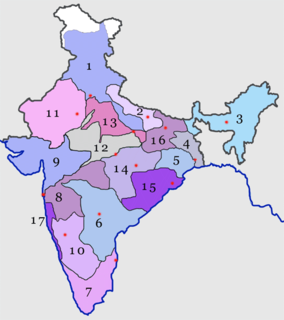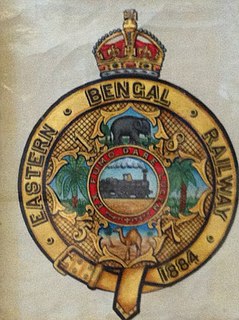
The Eastern Railway is among the 18 zones of the Indian Railways. Its headquarters is at Fairley Place, Kolkata and comprises four divisions: Howrah, Malda, Sealdah, and Asansol. Each division is headed by a Divisional Railway Manager (DRM). The name of the division denotes the name of the city where the divisional headquarters is located. Eastern Railway oversees the largest and second largest rail complexes in the country, Howrah Junction and Sealdah railway station, and also contains the highest number of A1 and A Category Stations like Howrah, Malda Town, Sealdah, Asansol, Kolkata, Durgapur, Barddhaman, Rampurhat Junction, Bhagalpur, Jasidih, Bandel and Naihati. Eastern Railways operates India's oldest train, Kalka Mail.

The South Eastern Railway is one of the 18 railway zones in India and Part of Eastern Railways. It is headquartered at Garden Reach, Kolkata, West Bengal, India. It comprises Adra railway division, Chakradharpur railway division, Kharagpur railway division and Ranchi railway division.

The Great Indian Peninsula Railway was a predecessor of the Central Railway, whose headquarters was at the Boree Bunder in Mumbai. The Great Indian Peninsula Railway Company was incorporated on 1 August 1849 by the Great Indian Peninsula Railway Company Act 1849 of the Parliament of the United Kingdom. It had a share capital of 50,000 pounds. On 21 August 1847 it entered into a formal contract with the East India Company for the construction and operation of a railway line, 56 km long, to form part of a trunk line connecting Bombay with Khandesh and Berar and generally with the other presidencies of India. The Court of Directors of the East India Company appointed James John Berkeley as Chief Resident Engineer and Charles Buchanan Ker and Robert Wilfred Graham as his assistants. It was India's first passenger railway, the original 21 miles (33.8 km) section opening in 1853, between Bombay (Mumbai) and Tanna (Thane). On 1 July 1925 its management was taken over by the Government. On 5 November 1951 it was incorporated into the Central Railway.

Birgunj is a metropolitan city in Parsa District in Madhesh Province of southern Nepal. It lies 135 km (84 mi) south of the capital Kathmandu, attached in the north to Raxaul in the border of the Indian state of Bihar. As an entry point to Nepal from Patna, Birgunj is known as the "Gateway of Nepal". It is also called "Commercial capital of Nepal". The town has significant economic importance for Nepal as most of the trade with India is via Birgunj and the Indian town of Raxaul. Tribhuvan Highway links Birgunj to Nepal's capital, Kathmandu.
Raxaul is a sub-divisional town in the East Champaran district of the Indian state of Bihar. It is situated at the India-Nepal border with Birgunj city (Nepal). Raxaul is a major railway junction.

The East Indian Railway Company, operating as the East Indian Railway, introduced railways to East India and North India, while the Companies such as the Great Indian Peninsula Railway, South Indian Railway, Bombay, Baroda and Central India Railway and the North-Western Railway operated in other parts of India. The company was established 1 June 1845 in London by a deed of settlement with a capital of £4,000,000, largely raised in London.
The Oudh and Tirhut Railway was a Railway company operated in India.

The Howrah–Delhi main line is a railway line connecting Delhi and Kolkata cutting across northern India. The 1,532 km (952 mi) railway line was opened to traffic in 1866 with the introduction of the "1 Down/2 Up Mail" train.

The Eastern Bengal Railway was one of the pioneering railway companies that operated from 1857 to 1942, in Bengal and Assam provinces of British India.

The Assam Bengal Railway (ABR) was one of the pioneering railway companies in British India. Headquartered in Chittagong, it functioned from 1892 to 1942.

Bareilly Junction railway station is a railway station serving Bareilly city in Uttar Pradesh. It is an important station as well as the headquarters of Izzatnagar railway division of the North Eastern Railway zone & Moradabad railway division of the Northern Railway zone. It lies on Lucknow–Moradabad line and Lucknow-Sitapur-Lakhimpur-Pilibhit-Bareilly-Kasganj Line provides a stop for most trains passing through. Bareilly Junction used to serve both broad and metre gauge, Bareilly Junction was connected to Lucknow by both Broad Gauge and Meter Gauge, Broad Gauge was connected to Lucknow via Tilhar,Shahjahanpur, Hardoi. On the other hand Meter Gauge was connected to Lucknow via Pilibhit-Mailani-Lakhimpur-Sitapur, but now the metre gauge is converted into broad gauge.
Tirhut Railway was originally owned by the Raj Darbhanga and later by the provincial government. Its ownership was later transferred to the Government of India which operated it as part of the Indian State Railways from opening to late 1886, as the Tirhoot Railway from late 1886 to 30 June 1890 and by the Bengal and North Western Railway from 1 July 1890. Tirhoot Railway absorbed the Segowlie-Raxaul Railway is around 1920. The Tirhut Railway was merged into the Oudh and Tirhut Railway on 1 January 1943.
Mashrak–Thawe Extension Railway was owned by the Government of India and worked by Bengal and North Western Railway.
The Lucknow–Bareilly Railway or Lucknow–Bareilly State Railway was owned by the Government of India and worked by the Rohilkund and Kumaon Railway. The Lucknow–Bareilly Railway was formed on 1 January 1891 by merger of Lucknow–Sitapur–Seramow Provincial State Railway and Bareilly–Pilibheet Provincial State Railway. The Lucknow–Bareilly Railway was merged into the Oudh and Tirhut Railway on 1 January 1943.
The Lucknow–Sitapur–Sehramau-Pilibhit Provincial State Railway was owned by the Provincial Government and worked as part of the Indian Railways.
Bareilly–Pilibheet Provincial State Railway was owned by the Provincial Government and worked by the Rohilkund and Kumaon Railway.
The Muzaffarpur–Sitamarhi section is a railway line connecting Muzaffarpur to Sitamarhi in the Indian state of Bihar. The 65.8 km (40.9 mi) line passes through the plains of North Bihar.
Badarpur railway station serves the Indian city of Badarpur in Assam. It belongs to Lumding railway division of Northeast Frontier Railway of India. It is located at Karimganj district in the state of Assam. It is one of the oldest station of India built in 1898. The Station connects Badarpur to other regions of Barak Valley as well as many parts of India.
Jiribam railway station serves Jiribam town and belongs to the Lumding railway division of Northeast Frontier Railway. It is the first railway station in the state of Manipur, India.
The Pakistan Eastern Railway was one of two divisions of Pakistan Railways which operated between 1961 and 1971. The company was headquartered in Chittagong. With the emergence of Bangladesh, it became Bangladesh Railway.